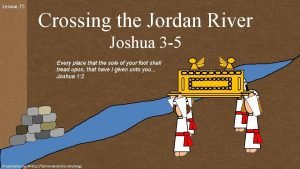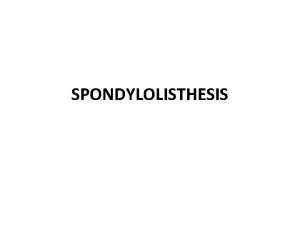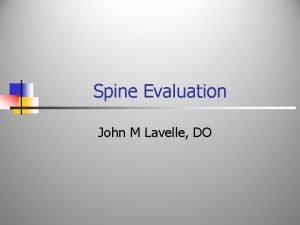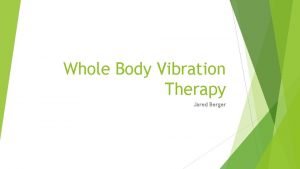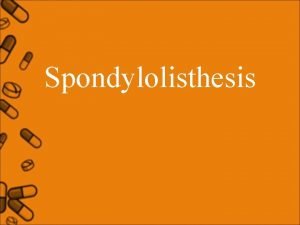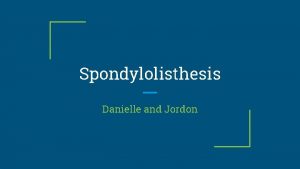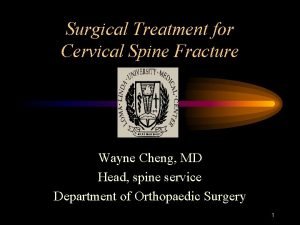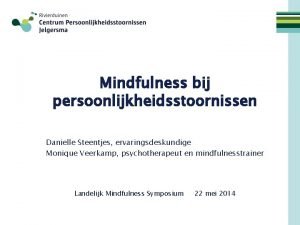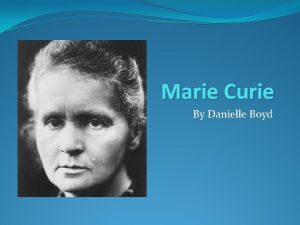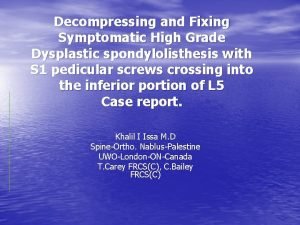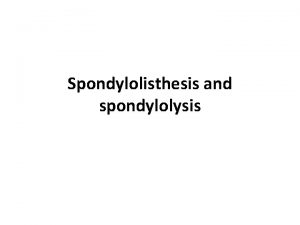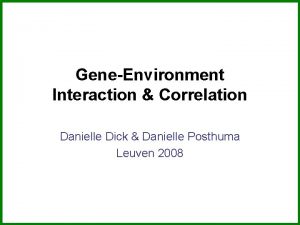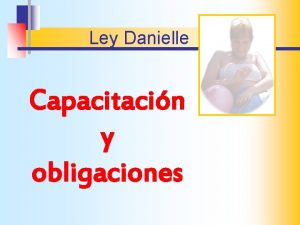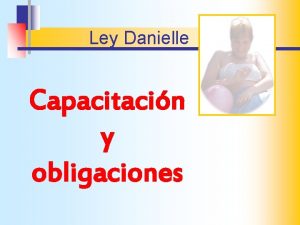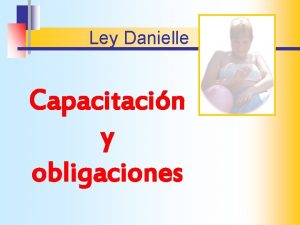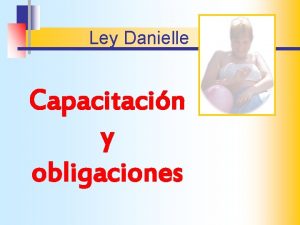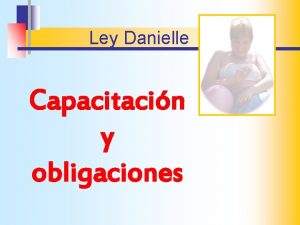Spondylolisthesis Danielle and Jordon What is it A













- Slides: 13

Spondylolisthesis Danielle and Jordon

What is it? A condition of the spine whereby one of the vertebra slips forward or backward compared to the next vertebra. Spondylolisthesis can lead to: Deformity of the spine A narrowing of the spinal canal (central spinal stenosis) Compression of the exiting nerve roots (foraminal stenosis). Last stage of progression of the spondylo-’s Spondylosis -> spondylolysis -> spondylolisthesis Most commonly occurs in the lumbar spine but can also occur in the thoracic and cervical spine

Types ● Most Common ○ Degenerative: breakdown of IVD ○ Isthmic: results from spondylolysis, aka “scottie dog fracture” ○ Congenital: abnormal bone formation ● Less Common ○ Traumatic: severe hyperextension ○ Pathological: weakened by disease ○ Post-surgical: defect becomes worse after spinal surgery

Grades ● Grades 1 & 2 typically respond well to conservative treatment ● Grades 3 & 4 might require surgery depending on neurological compromise ○ Includes: spinal fusion and/or laminectomy ○ Surgical approach for degenerative spondylolisthesis along with spinal stenosis has long term benefits. (NEJM, 2007) Cleveland Clinic (2009)

Clinical Manifestations Patients are usually asymptomatic However, those that are symptomatic most commonly report PAIN as their main issue Exacerbated by twisting and extension movements If slippage is severe enough, Can develop N/T or weakness of the legs due to nerve compression Can lose control of bowel and bladder function due to cauda equina syndrome Other signs: Tightness in hamstrings Decreased ROM W/ advanced stages of pregnancy, reported symptoms become more severe

Physical Examination Findings Tenderness to deep palpation of the spinous process above the slip With high-grade slips, a palpable step-off may be felt over the spinous process at the level above the slipped vertebrae Paraspinal muscle spasms Abnormal gait pattern that is “waddle -like” due to hamstring tightness Weakness in Anterior Tibialis (L 4) is common Neural Signs

Treatment Approaches Generally, Those that are grades 1 and 2 will have the most benefit from conservative approaches Unless, neural signs are present during these grades, then it is recommended to receive surgery Those that are grades 3 and 4 surgery is recommended to correct it Conservative Approaches Physical Therapy Bracing Rest and avoiding activities that involve lifting and bending NSAID’s, ice, and heat

Physical Therapy Approach to Treatment Therapeutic Exercise Strengthen abdominal muscles Exercises that promote flexion Posterior tilt exercises Hamstring stretching Stabilization exercises Therapeutic Exercise + Bracing Best results in reduction of pain when used in combination Patient education to maintain healthy weight and well-balanced diet as well as to avoid activities/sports that involve hyper-extension of the back

Orthotic Treatment of DDD with Degenerative Spondylolisthesis: A Case Study Meade K, Flanagan P, Gomez JM JOP 2006 ● The Patient ○ 66 y. o. Female, mother of 7, full-time retail worker with bilateral TKA ○ Back pain since 1999, worsening with achy, burning sensation from right buttock down to her foot ○ VAS: 8/10 ○ Unable to walk more than 50 yards without having to sit to relieve pain ○ Restless sleep pattern due to cramping and numbness in bilateral LEs ○ Ambulates with considerable bend forward posture ○ Takes 6 NSAID tablets daily to control pain ○ Attempted PT but was restricted by pain levels

Exam Findings Physical Exam ● Normal motor function ● Reduced reflexes: 2 @ L 4, 0 @ L 5 -S 1 ● Positive plantar babinski Radiology ● X-ray revealed DDD with Grade 1 Spondi @ L 5 -S 1 and advanced DDD at L 4 -L 5 ● MRI confirmed spinal stenosis at L 4 L 5 Treatment ● Custom anterior opening LSO along with PT ○ Casted with pt in supine with knees bent to reduce sacral angle ● Regular visits during first 4 months to check fit along with x-rays while wearing orthotic to track progress ● After 4 months, follow up was made every 4 months via phone calls until end of 18 months. * Pt. opted for conservative treatment even though surgery was recommended due to her neurological symptoms.

Results ● Reported immediate relief in pain and ability to sleep through the night (wearing orthotic at night) ● At 4 months ○ Able to remain standing for 30 minutes and normal duties at work ● At 6 months ○ VAS 2/10 and complete discontinuation of NSAIDS ● At 18 months ○ X-ray confirmed reduction in sacral angulation (equates to a 42% reduction in shear forces) ○ Pt reduced orthotic wear to 4 -6 hours a day, during most active time of day with continuation of prescribed exercises.

Questions?

References Das P. Spondylolisthesis Treatment. Physiotherapy-Treatment. com. Accessed on July 10, 2016 from http: //www. physiotherapytreatment. com/spondylolisthesis-treatment. html Driver C. Spondylolisthesis. Medicine. Net. Reviewed on May 8, 2015. Accessed on July 10, 2016 from http: //www. medicinenet. com/spondylolisthesis/article. htm. Meade K, Flanagan P, Gomez JM. Orthotic Treatment of Degenerative Disc Disease with Degenerative Spondylolisthesis: A Case Study. JPO 2006; 18: 8 -14. Retrieved from American Academy of Orthotists and Prosthetists Website. http: //www. oandp. org/olc/course_jpo. asp? frm. Course. Id=87 E 71 C 33 -9615 -4 CDD-BE 40 -0 CD 809 D 9 F 0 B 7. Accessed July 10, 2015. Perrin A. Lumbosacral Spondylolisthesis Clinical Presentation. Medscape. Updated Feb 1, 2016. Accessed on July 10, 2016 from http: //emedicine. medscape. com/article/2179163 -clinical#b 3 Spondylolisthesis. Disease and Conditions Cleveland Clinic. Retrieved from http: //my. clevelandclinic. org/health/diseases_conditions/hic_your_back_and_neck/hic_Spondylolisthesis. Updated October 9, 2009. Accessed July 5, 2016. Weinstein JN, Lurie JD, Tosteson TD, et al. Surgical versus Nonsurgical Treatment for Lumbar Degenerative Spondylolisthesis. N Engl J Med 2007; 356: 2257 -2270. DOI: 10. 1056/NEJMoa 070302.

